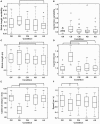Usability of Three-dimensional Augmented Visual Cues Delivered by Smart Glasses on (Freezing of) Gait in Parkinson's Disease
- PMID: 28659862
- PMCID: PMC5468397
- DOI: 10.3389/fneur.2017.00279
Usability of Three-dimensional Augmented Visual Cues Delivered by Smart Glasses on (Freezing of) Gait in Parkinson's Disease
Abstract
External cueing is a potentially effective strategy to reduce freezing of gait (FOG) in persons with Parkinson's disease (PD). Case reports suggest that three-dimensional (3D) cues might be more effective in reducing FOG than two-dimensional cues. We investigate the usability of 3D augmented reality visual cues delivered by smart glasses in comparison to conventional 3D transverse bars on the floor and auditory cueing via a metronome in reducing FOG and improving gait parameters. In laboratory experiments, 25 persons with PD and FOG performed walking tasks while wearing custom-made smart glasses under five conditions, at the end-of-dose. For two conditions, augmented visual cues (bars/staircase) were displayed via the smart glasses. The control conditions involved conventional 3D transverse bars on the floor, auditory cueing via a metronome, and no cueing. The number of FOG episodes and percentage of time spent on FOG were rated from video recordings. The stride length and its variability, cycle time and its variability, cadence, and speed were calculated from motion data collected with a motion capture suit equipped with 17 inertial measurement units. A total of 300 FOG episodes occurred in 19 out of 25 participants. There were no statistically significant differences in number of FOG episodes and percentage of time spent on FOG across the five conditions. The conventional bars increased stride length, cycle time, and stride length variability, while decreasing cadence and speed. No effects for the other conditions were found. Participants preferred the metronome most, and the augmented staircase least. They suggested to improve the comfort, esthetics, usability, field of view, and stability of the smart glasses on the head and to reduce their weight and size. In their current form, augmented visual cues delivered by smart glasses are not beneficial for persons with PD and FOG. This could be attributable to distraction, blockage of visual feedback, insufficient familiarization with the smart glasses, or display of the visual cues in the central rather than peripheral visual field. Future smart glasses are required to be more lightweight, comfortable, and user friendly to avoid distraction and blockage of sensory feedback, thus increasing usability.
Keywords: Parkinson’s disease; augmented reality; external cueing; freezing of gait; smart glasses; visual cues; wearables.
Figures




Similar articles
-
The Beneficial Effects of Conventional Visual Cues Are Retained When Augmented Reality Glasses Are Worn.Parkinsons Dis. 2020 Apr 7;2020:4104712. doi: 10.1155/2020/4104712. eCollection 2020. Parkinsons Dis. 2020. PMID: 32322385 Free PMC article.
-
Feasibility of external rhythmic cueing with the Google Glass for improving gait in people with Parkinson's disease.J Neurol. 2016 Jun;263(6):1156-65. doi: 10.1007/s00415-016-8115-2. Epub 2016 Apr 25. J Neurol. 2016. PMID: 27113598 Free PMC article. Clinical Trial.
-
The Effects of Augmented Reality Visual Cues on Turning in Place in Parkinson's Disease Patients With Freezing of Gait.Front Neurol. 2020 Mar 24;11:185. doi: 10.3389/fneur.2020.00185. eCollection 2020. Front Neurol. 2020. PMID: 32265826 Free PMC article.
-
Cueing for people with Parkinson's disease with freezing of gait: A narrative review of the state-of-the-art and novel perspectives.Ann Phys Rehabil Med. 2018 Nov;61(6):407-413. doi: 10.1016/j.rehab.2017.08.002. Epub 2017 Sep 7. Ann Phys Rehabil Med. 2018. PMID: 28890341 Review.
-
Cueing for freezing of gait in patients with Parkinson's disease: a rehabilitation perspective.Mov Disord. 2008;23 Suppl 2:S475-81. doi: 10.1002/mds.21978. Mov Disord. 2008. PMID: 18668619 Review.
Cited by
-
Transverse Strips Instead of Wearable Laser Lights Alleviate the Sequence Effect Toward a Destination in Parkinson's Disease Patients With Freezing of Gait.Front Neurol. 2020 Aug 12;11:838. doi: 10.3389/fneur.2020.00838. eCollection 2020. Front Neurol. 2020. PMID: 32903360 Free PMC article.
-
A Technological Review of Wearable Cueing Devices Addressing Freezing of Gait in Parkinson's Disease.Sensors (Basel). 2019 Mar 13;19(6):1277. doi: 10.3390/s19061277. Sensors (Basel). 2019. PMID: 30871253 Free PMC article. Review.
-
Gait festination in parkinsonism: introduction of two phenotypes.J Neurol. 2019 Feb;266(2):426-430. doi: 10.1007/s00415-018-9146-7. Epub 2018 Dec 7. J Neurol. 2019. PMID: 30536108 Free PMC article. Review.
-
Therapeutic Devices for Motor Symptoms in Parkinson's Disease: Current Progress and a Systematic Review of Recent Randomized Controlled Trials.Front Aging Neurosci. 2022 Mar 29;14:807909. doi: 10.3389/fnagi.2022.807909. eCollection 2022. Front Aging Neurosci. 2022. PMID: 35462692 Free PMC article. Review.
-
Detection and assessment of Parkinson's disease based on gait analysis: A survey.Front Aging Neurosci. 2022 Aug 3;14:916971. doi: 10.3389/fnagi.2022.916971. eCollection 2022. Front Aging Neurosci. 2022. PMID: 35992585 Free PMC article. Review.
References
LinkOut - more resources
Full Text Sources
Other Literature Sources

